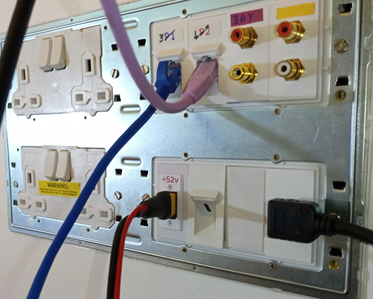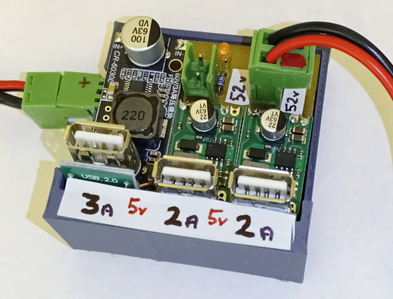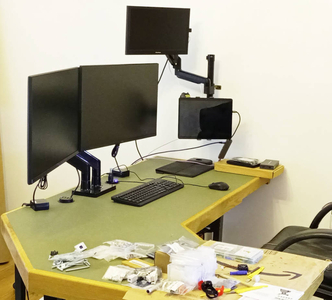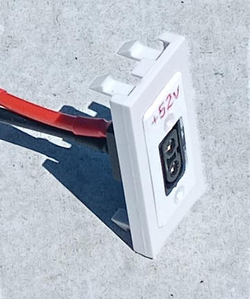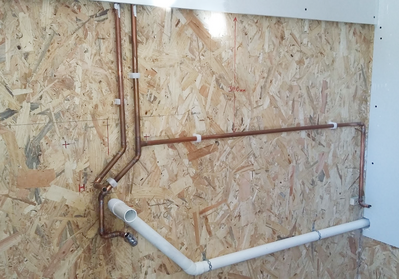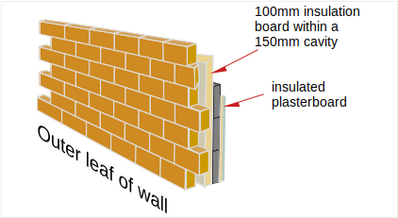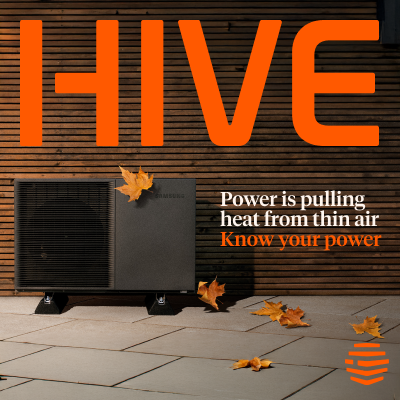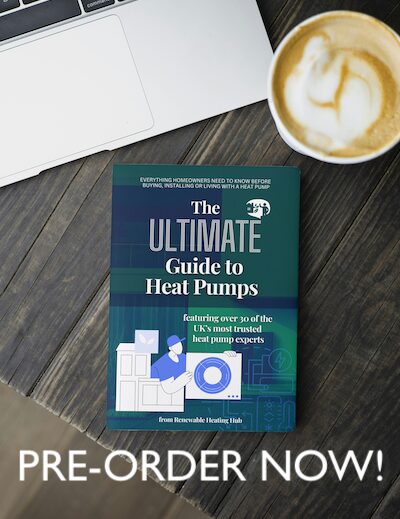[Sticky] Say hello and introduce yourself
Posted by: @jarlatheoinWould be keen to talk to some people with experience of a self build in recent times to bounce some questions off.
Hi @jarlatheoin You're in the right place.
I'm a hands-on self-builder.
Irrespective of the name of this forum, you are free to start any building question-topic here.
It doesn't have to be heat-pump related,
nor anything to do with energy.
When you start such a topic please give us an overview of the build-style (brick, SIP, timber frame etc),
and how much of this work you'd like to do yourself.
Please tag me so that I get notified of the new topic.
I have hands-on experience of
- solar PV
- solar thermal
- micro wind-turbine
- storage-battery & inverters
- whole-house ventilation (MVHR)
- radiators and UFH (both solid and suspended flooring)
- CCTV, IR lighting and alarm
- off-grid operation, both at 240v AC and low-voltage DC for lighting, computers, and emergency devices
- mains, data and LV wiring, safety-trips and connectors
Photo below shows 'work in progress':
I know my way around the Building Regulations, planning regulations, and obtaining consent from 3rd parties where necessary.
Let us know which local planning authority (LPA) you're in.
Over to you!
Save energy... recycle electrons!
@transparent - as a matter of interest whats 52V for? It sounds close to being like a telephone system (usually 48V) but I presume not!
4kW peak of solar PV since 2011; EV and a 1930s house which has been partially renovated to improve its efficiency. 7kW Vaillant heat pump.
Hi,
Thank you for the reply and the associated link, some light bedtime reading 😉
Some more information regarding our build:
- NW Northern Ireland (Derry City and Strabane District Council)
- Block built, 150mm Cavity with 100mm PIR Insulation
- 1 1/4 storey
- Internal walls on the exterior leafs will have insulation backed plaster board.
- Plan for triple glazing panels on all uPVC frames.
- 3000 kWh energy consumption over the year or there about's for electricity
- Current property is a similar size and we are using 2000 litres of Kero per year to heat
Current pondering:
- Solar PV or not
- Air Source Heat Pump + Underfloor heating or Kerosene Condenser Boiler + Underfloor (Both solutions with rads upstairs)
- Mechanical Heat Recovery or not
Thank you in advance,
Jarlath
You have come to the renewable heating hub so there may be bias, but I would say
1 it depends on your priorities: minimum capital cost/minimum running cost/rate of return/environmental/comfort it would help if you have us a bit of a clue.
2. Unless you are considering in-roof, then solar PV is an easy retrofit, so if capital available limits what you can do now then this is the one to defer.
3. Whether you choose kerosene or heat pump, size the rads for the same low flow temp as the ufh. It's entirely pointless having a condensing boiler and running it at 70C flow temperature (then mixing down for ufh), it won't condense. This does mean larger rads so build this into the planning as early as possible. This works best for a heat pump as well.
4 . Get a well sized well insulated unvented cylinder, preferably with a 'heat pump coil' (3 sq m). This will also be better with a boiler and will future proof. A cylinder lasts 25+ years, a boiler typically 10-15, so you want a cylinder that will do whatever is needed (almost certainly ashp) in 15 years time.
As to the trade offs
Heat pump will limely be a bit (perhaps 1-4k) more expensive to buy than a kerosene boiler, but you may be able to offset this with a grant, although they come with baggage which you may wish to avoid! It should be cheaper to run but the relationship between kerosene prices and electricity prices is quite volatile (think back a few years) so in any one year that's not guaranteed. Heat pump will have one quarter the carbon emissions and this will reduce with time, kerosene will continue to warm the planet as well as your house. Heat pumps with ufh can do cooling also, which you can't do with a kerosene boiler (for me that clinches it, there are enough hot days to justify a bit of cooling, but nothing like enough to dedicate a separate system to it, so ashp is just the ticket). For cooling, unless you got to significant lengths to prevent condensation, you need a heat pump that can monitor dew point and operate just above, some (eg valiant) do that natively, others not.
I switched from gas to ashp (as a retrofit) and if I were self building it would be ashp every time, no question. It's just so much better.
If you do go for ashp please reread my initial reply and ask me to unpack some of the densely packed advice if you need.
Solar panels last for decades.and should more than will pay for themselves over time (would need to do the calcs to see how long if it's crucial, particularly in NI where there are more cloudy days than in se England). If you do go for them get as many as you can fit. You need a decent export tarrif or a battery to take full advantage.
The business and environmental case for batteries is iffy at best, but if you are going to get a battery do it at the same time as the solar because it will be cheaper. The capabilities of the controller affect what you can do in terms of tarrifs optimisation, so this needs to be chosen carefully. I have solar, fitted in 2011 and no battery, the latter because I can't get the business case to work given I can get a decent (16.5p) export tarrif.
I don't have mvhr but if I were building from scratch would almost certainly put it in. @transparent can probably comment more on this.
Hope that helps, ask some more and tell us a bit about priorities/constraints.
4kW peak of solar PV since 2011; EV and a 1930s house which has been partially renovated to improve its efficiency. 7kW Vaillant heat pump.
Posted by: @jamespaas a matter of interest whats 52V for?
I'll admit that a 52v wall outlet is rare.
I presently have just two, and both are in my study/workshop area.
Most of my household DC wiring is for fixed apparatus... usually a DC-DC converter to 24v or 12v.
But there are occasions when I want to connect a more complex arrangement of devices which operate at different voltages,
and/or where the arrangement isn't permanent, such as a desk which can be moved.
For those situations I've installed a high-current wall socket, such as those commonly used by drone operators and RC model enthusiasts.
My choice of 'standard' is an XT60, for which Amass is the main manufacturer.
This is the basic arrangement:
All of these component parts are obtainable online, either in the UK, or at a much cheaper price from AliExpress.
My 52v wall outlet is created from a 50x25mm modular blanking plate.
I'm going to relocate these explanations to a separate topic if there are any further questions
... at which point I'll add a link here of course, so that others can follow what's being discussed.
Save energy... recycle electrons!
Posted by: @jarlatheoinMechanical Heat Recovery or not
Well now's the time to think about it!
There's no harm with putting in the (relatively cheap) pipework, and deciding later whether to add the active heat-exchanger.
There's a topic on whole-house ventilation here which has useful diagrams and discussion points.
Save energy... recycle electrons!
@jamespa thank you for the response. At the moment the focus is controlling capital investment at this point in time but wanting to keep a mind towards forward planning. We are both in our early 40s and would like to have a home when we reach retirement age that is not a financial noose around our neck with monthly bills.
@transparent that's definitely a very valid point. Go half ways there for now. I have heard a lot of people speak to its virtues but I am wary that people are not likely to point out the failings of systems that they have invested heavily in. Most information that is available is either sales collateral or heavily covered in positive bias.
Posted by: @jarlatheoin@jamespa thank you for the response. At the moment the focus is controlling capital investment at this point in time but wanting to keep a mind towards forward planning. We are both in our early 40s and would like to have a home when we reach retirement age that is not a financial noose around our neck with monthly bills.
Ok. I'm presuming you also want to avoid spending on things you will discard before their natural end of life so:
Leave solar panels for now, put in ducting for mvhr as @transparent says.
Design heating system for a heat pump (because this is best for both heat pump and boiler). No fancy controls, they are a waste of money, no buffer tanks, no mixing valves, rads sized for same flow temp as ufh. Diverter valve between UVC and space heating.
Then either fit a cheap boiler or a cheap heat pump (plenty of Samsung gen6 heat pumps around for every little, crap interface but homely sorts it. Also a bit ugly and noisy, which may or may not matter depending on how much space you have). You haven't said what the design loss is but I'm guessing 6kW or less given the build spec, you can't get a heat pump much smaller than 5kW (other than ones down rated in firmware, which doesn't help a lot) so choice much simplified.
If you can stretch to if, fit a less cheap heat pump (prettier, quieter, better UI). I happen to have a 7kW Vaillant with which I am very pleased, likely the 5kW would work for you. There are plenty out there but check that either it is homely compatible or has a UI which allow to program a room temperature but which, under the hood, is actually shifting the WC curve. Vaillant and ideal do that, not sure which others do. More likely to be found on European brands because they have had to deal with mandatory weather compensation for boilers.
If you can fill in some paperwork, do a bit of design and have a decent plumber then you might the heat pump etc paid for more or less entirely under the bus grant by going through an mcs umbrella scheme. I can say more about this if you are that way inclined.
How much are you actually doing yourself and what is the arrangement with the trades (eg prime contractor wholly responsible , individual tradesmen, or you doing some actual build) That may influence the options.
Hope that helps.
4kW peak of solar PV since 2011; EV and a 1930s house which has been partially renovated to improve its efficiency. 7kW Vaillant heat pump.
Whilst you're busy installing services (pipes and wires) I strongly recommend that you photograph everything.
I actually draw my construction lines and write dimensions onto the wall as I work.
That way, I will know precisely where each pipe is in future years without having to dismantle the top layer!
For the benefit of others who come across this discussion in future, I'm going to pick up an unusual part of @jarlatheoin's design...
Posted by: @jarlatheoin- Block built, 150mm Cavity with 100mm PIR Insulation
- 1 1/4 storey
- Internal walls on the exterior leafs will have insulation backed plaster board.
When using concrete block and other heavy building materials, it is normally the case that you want these to contribute to the thermal mass of the home.
However, in this case @jarlatheoin is going to use internal wall insulation (in addition to an insulated cavity).
The main wall elements will be outside the 'thermal envelope' of the house.
Save energy... recycle electrons!
- 26 Forums
- 2,136 Topics
- 46.8 K Posts
- 25 Online
- 5,662 Members
Join Us!
Podcast Picks
Latest Posts
-

RE: Does anyone have experience of a smart water meter?
Sorry, @transparent, but I disagree. Legislation brough...
By Majordennisbloodnok , 8 hours ago
-
RE: Heat Pump Servicing & Maintenance – Good Value or Rip-Off?
Having bit the bullet and paid £250 for a service, our ...
By Old_Scientist , 14 hours ago
-

@bontwoody me too. I've contacted Heat Geek today, and ...
By Mars , 19 hours ago
-
New heat pump heating system underperforming in Italy... Advice needed!
hi all, first post! I've just renovated a house in sout...
By robinlawrie , 19 hours ago
-
RE: Anyone still weathering it out with Agile?
I went to Agile when I had solar installed July last ye...
By NJT , 1 day ago
-
RE: Mitsu Wireless Controller and MelCloud
Well it has now become obvious that the installation of...
By DavidAlgarve , 2 days ago
-

RE: Say hello and introduce yourself
Whilst you're busy installing services (pipes and wires...
By Transparent , 3 days ago
-
RE: New Vaillant aroTherm Plus in black - When will it come to the UK?
@editor I know it was formally announced at Ish the oth...
By PatrickVito , 4 days ago
-

@moman0311 welcome to the forums. I've received your em...
By Mars , 4 days ago
-
RE: Thermostat for Ideal Logic Air with 3 zone support
No harm at all in plumbing it as 3 zones, I would have ...
By JamesPa , 5 days ago
-
RE: ASHP heat output monitoring
@carlo I see there is a discussion in Facebook user gro...
By Tim441 , 5 days ago
-
RE: Flexi-Orb Heat Pump Scheme: A Game-Changer for the UK's Heat Pump Industry
MCS have set a potential trap in the new version of MCS...
By JamesPa , 6 days ago
-
RE: Who has a V2G EV installation
General comment on battery care... I guess if ev is on ...
By Tim441 , 7 days ago
-
@old_scientist like for like comparisons are almost imp...
By Tim441 , 7 days ago
-

RE: Who's your electricity provider and what's your tariff?
@old_scientist There is an option in the Tesla app that...
By Toodles , 7 days ago
-
RE: Octopus Cosy & Octopus EV + bidirectional smart tariff, together. What, eh?
@old_scientist me too. Just installed my new heat pump ...
By Eliuccio , 1 week ago
-
RE: Is your heat pump insured?
Yup just spoke to Privilege to inform them of my impend...
By Scalextrix , 1 week ago
-

RE: Forum updates, announcements & issues
Just to keep everyone in the loop, as the site continue...
By Mars , 1 week ago
-

RE: Fast DHW setting on Midea (Clivet) heat pump
@simon-w, is this something you could potentially assis...
By Mars , 1 week ago
-
RE: Share Your Experiences with Heat Pump Manufacturer Support
Fwiw I called my installer out for the first time a few...
By JamesPa , 1 week ago

